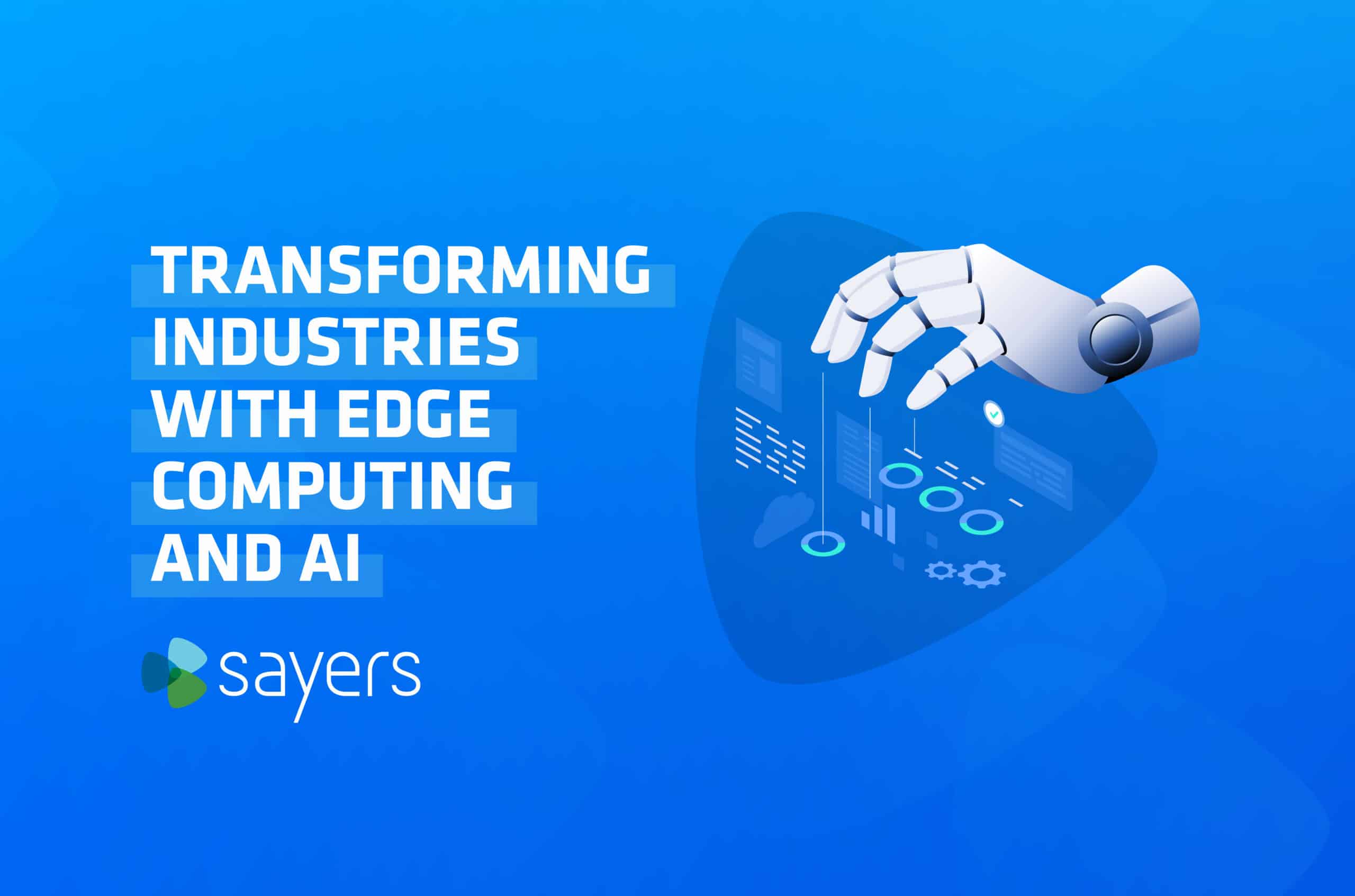Transforming Industries With Edge Computing And AI
Posted September 5, 2024 by Sayers

In our world of exponential data growth and massive amounts of AI-fueling data, what will organizations do with all that data? The question may not be what, but where – as the ability to process data and derive value from it increasingly moves to the network’s edge.
What Is Edge Computing?
The edge is where the physical and digital meet, where things such as IoT devices and people including your customers and employees generate or consume data. Edge computing processes that data closer to its source, where people and devices are connected to the network, rather than sending data back and forth to a centralized cloud or primary data center.
By bringing data computation, storage, and analysis closer to the edge of the network, edge computing reduces latency, makes data processing more reliable and efficient, and improves data privacy and security.
If your main data center goes down, edge computing allows your branch office or warehouse to continue processing. When you have high-volume data produced or stored at the edge, edge computing can dedupe that data. This reduces the noise and the required bandwidth before you send the data up to a public cloud or back to your main data center for continued analysis.
Data processing at the edge reduces wait time, enabling real-time decision-making and customer interactions. For example, a sports fan who has used an app to order hot dogs in an arena doesn’t want to wait several minutes for confirmation. Edge computing in the arena can reduce the latency and process the request faster.
Wade Scheffner, Solutions Architect at Sayers, says:
“Edge computing allows for a digital transformation. It’s easier to do things at the edge that you normally wouldn’t do in the data center. You can process and analyze more data with faster insight. That’s because with edge computing you’ve reduced the latency and bandwidth issues and there’s not as much data or footprint. It’s a keen opportunity to start doing things differently.”
Hyperconverged infrastructure (HCI) platforms can help organizations bring compute and storage to the edge while keeping the total cost of ownership low from a cost and administration standpoint. Scheffner adds:
“Edge computing is not just GPUs, data storage, and servers. Think of edge computing as a mini data center that also requires routing, networking, security, and observability at the edge.”
The Impact of AI And Machine Learning On Edge Computing
Edge computing solutions can integrate AI algorithms designed to quickly analyze vast amounts of data. According to Gartner:
By 2026, at least 50% of edge computing deployments will involve machine learning, compared to 5% in 2022.
AI and machine learning are only as good as the data you’re analyzing. In your main data center, you might have 50 terabytes of data requiring processing and analysis to train your machine learning models. Compare that to the edge where you might have only one terabyte, making it much easier to start using AI to quickly gain insights and value from your data.
Gartner further predicts:
More than 55% of all data analysis by deep neural networks will occur at the point of capture in an edge system by 2025, up from less than 10% in 2021. Organizations should identify the applications, AI training, and inferencing required to move to edge environments near IoT endpoints.
Edge Computing Sees Growth In Industry Verticals And Use Cases
Thanks to the Internet of Things, industries have more data available than ever before.
The edge is everywhere, including IoT devices, sensors, wearables, retail stores, hospitals, manufacturing plants, and much more.
Data at the edge continues to grow, reaching 2,763 exabytes by 2026 according to Dell Technologies. With edge computing, a variety of industries can process that data more quickly and efficiently to improve processes.
Based on Gartner’s 2023 CIO and Technology Executive Survey:
Transportation, manufacturing and natural resources, and energy/utilities top the list of verticals that have deployed or plan to deploy edge computing within two to three years.
The real-time data processing of edge computing helps organizations achieve new capabilities for business, people, and/or things. A closer look shows why the following verticals are primed for edge computing adoption and expansion:
Manufacturing organizations want to automate for efficiency and improve safety with edge use cases including predictive maintenance, anomaly detection, and quality control. System automation enables manufacturing plants to be more efficient and ensures their firmware stays current.
Retail businesses seek to make the most of real-time analytics and inventory management while providing a personalized and immersive customer experience.
Energy companies continue to adopt smart grids and want improved observability and automation. With real-time analysis and control, they can make grid adjustments in real time based on consumption.
Transportation companies benefit from predictive maintenance using sensors that identify potential problems before they become an issue. Edge computing also enables client content delivery such as boarding notifications and updates to passengers’ smartphones.
Healthcare demands data privacy and security, as well as rapid response with treatment based on the most current patient data. Edge computing in healthcare translates to faster diagnostics, remote monitoring, and efficient management of IoT devices such as wearables and sensors.
Ask These Questions About Your Edge Computing Journey
As your organization begins or expands its edge computing initiatives, include these questions in your discussions:
- How critical is real-time data processing and analysis to your organization? Do you need to reduce latency?
- What are your primary use cases or applications that could benefit from edge computing?
- Are you currently using any edge devices or solutions – essentially anything outside of your primary data center? If so, what challenges have you encountered?
- How do you manage data security and privacy at the edge? How do you back up that data?
Questions? Contact us at Sayers today to discover extensive technology solutions, services, and expertise to cover all areas of your business.


